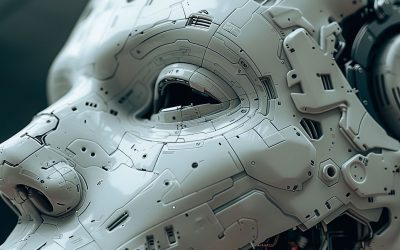Imagine a world where the line between human and machine blurs, where our biological limitations are overcome by merging with artificial intelligence. This isn’t science fiction—it’s the future envisioned by futurist Ray Kurzweil in his groundbreaking book, “The Singularity is Nearer: When We Merge with AI.” But what exactly is the Singularity, and how close are we to this technological revolution?
In this blog post, we’ll explore Kurzweil’s predictions and the potential impacts of Singularity on our society, economy, and the very nature of what it means to be human. Whether you’re a tech enthusiast, a skeptic, or simply curious about the future, this exploration of the Singularity will challenge your perceptions and open your mind to the possibilities.
What is the Singularity?
Defining the Technological Singularity
As popularized by Kurzweil, Singularity refers to a hypothetical time when artificial intelligence surpasses human intelligence, leading to rapid and exponential growth in technological progress. This event is expected to result in profound changes to human civilization, including merging biological and artificial intelligence.
“The Singularity will represent the culmination of the merger of our biological thinking and existence with our technology, resulting in a world that is still human but that transcends our biological roots.” – Ray Kurzweil [Source: “The Singularity is Near“]
Key Characteristics of the Singularity:
- Exponential technological growth
- Artificial General Intelligence (AGI) surpasses human intelligence
- Merging of human and machine intelligence
- Radical transformation of human society and capabilities
The Path to the Singularity
Moore’s Law and Exponential Growth
Kurzweil’s predictions are based on exponential growth, particularly in computing power. This is exemplified by Moore’s Law, which observes that the number of transistors on a microchip doubles every two years while the cost halves.
- 1965: Approximately 50 transistors per chip
- 2021: Over 50 billion transistors on leading-edge chips [Source: IEEE Spectrum]
Advancements in AI and Machine Learning
Recent breakthroughs in artificial intelligence and machine learning are accelerating our progress towards the Singularity:
- Deep Learning: Enabling machines to learn from vast amounts of data
- Natural Language Processing: Improving human-machine communication
- Computer Vision: Allowing machines to interpret and understand visual information
- Reinforcement Learning: Enabling AI to make complex decisions and improve through experience
Merging with AI: The Human-Machine Symbiosis
Brain-Computer Interfaces (BCIs)
One of the critical technologies Kurzweil predicts will lead to the Singularity is the development of advanced brain-computer interfaces. These devices allow direct communication between the human brain and external devices, potentially enhancing our cognitive abilities.
Recent advancements in BCIs:
Nanotechnology and the Human Body
Kurzweil envisions a future where nanobots coursing through our bloodstream repair and enhance our biological systems. This could lead to:
- Enhanced immune systems
- Reversal of aging processes
- Augmented sensory experiences
- Direct neural connections to the cloud
Potential Impacts of the Singularity
Economic Transformation
The Singularity is expected to bring about significant changes to the global economy:
- Automation of most jobs
- Universal Basic Income (UBI) is a potential solution
- Shift towards a post-scarcity economy
- New industries and job categories emerging
Ethical and Philosophical Considerations
As we approach the Singularity, several ethical questions arise:
- What does it mean to be human in a world where we merge with AI?
- How do we ensure equitable access to these transformative technologies?
- What are the implications for privacy and personal autonomy?
- How do we maintain control over superintelligent AI systems?
Social and Cultural Impact
The Singularity is likely to have profound effects on human society and culture:
- Redefinition of work and leisure
- Potential for increased human lifespan or even immortality
- Changes in education and skill acquisition
- Evolution of social relationships and communication
Preparing for the Singularity
Skills for the Future
To thrive in a post-Singularity world, consider developing these skills:
- Adaptability and lifelong learning
- Creativity and problem-solving
- Emotional intelligence and interpersonal skills
- Ethics and Philosophy
- Understanding of emerging technologies
Staying Informed and Engaged
To keep up with the rapid pace of technological change:
- Follow reputable technology news sources
- Participate in online courses and webinars on AI and emerging tech
- Engage in discussions about the ethical implications of these technologies
- Consider joining organizations focused on responsible AI development
Conclusion
The concept of the Singularity, as presented in Ray Kurzweil’s “The Singularity is Nearer,” offers a glimpse into an exciting and daunting future. As we stand on the brink of this technological revolution, we must approach it with open minds, critical thinking, and a commitment to shaping a future that benefits all humanity.
Whether the Singularity unfolds exactly as Kurzweil predicts or takes a different path, one thing is sure: the coming decades will bring unprecedented changes to our world. We can prepare ourselves to navigate and thrive in this transformative era by staying informed, engaged, and adaptable.
What are your thoughts on the Singularity? Do you believe we’re on the cusp of merging with AI, or is this vision still far in the future? Share your opinions in the comments below, and let’s continue this meaningful conversation about our collective future.
References:
- Technological singularity – Wikipedia
- Brain-computer interface – Wikipedia
- Nanoscience and Human Enhancement: Ethical Dilemmas Arise as Technology Advances – The Guardian
- Q&A: Nanobots could explore human cells – but their size is an engineering challenge – Horizon Magazine
- Yes, nanoscience can enhance humans – but ethical guidelines must be agreed – The Guardian




